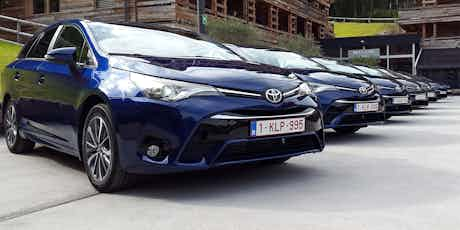Toyota Auris and Avensis road test
July 15, 2015 by carwow staff

Burnaston in the UK is the only Toyota factory outside Japan to be entrusted with manufacturing two cars simultaneously. Amazingly, this little town produces more cars annually than Italy and this is the latest pair.
The Auris is Toyota’s family hatchback – the second biggest car market in the UK, in which Toyota holds a 5% share – while the Avensis is the marque’s flagship saloon. Here are the things potential buyers need to know.
Svelte new styling

It wouldn’t be unfair to say previous Avensis and Auris models have been a bit on the dull side. While the car’s predecessors were unadventurous, the new ones are pretty sleek looking with an angular, distinctly Japanese appearance.
The designers have pushed the foglights out into the furthest corners of the bumper to make you think they are lower and wider than they actually are. Combined with a falcon-like chrome line that heads from the centre badge out and over the lights, the car looks much more eye-catching than before.
Relaxed driving experience

Everything about the way both cars drive imparts a feeling of serenity. None of the controls are excessively heavy and, from city streets to motorways to winding mountain passes, neither car generated much tension.
There’s not a lot to excite enthusiasts in either model, but they offer plenty of reassuring grip. The Avensis is marginally the more planted car, followed by the Auris hatchback.
Hybrid power and new engines

You can buy an Auris with the same Hybrid system found in many generations of Prius. This only adds to the calm driving experience, with speeds up to 44mph possible without engaging the engine. If you need a bit more power, to climb a hill for instance, the 1.8-litre unit will kick in (somewhat raucously) and you can charge the battery back up as you coast down afterwards.
There’s a new range of diesel engines, bought in from BMW, that provide more conventional experiences. In both cases, we’d avoid the smaller units (1.4 in the Auris, 1.6 in the Avensis) because we found they felt strained on bigger hills.
You’ll also find a neat 1.2-litre turbo petrol in the Auris that’s worth a look. It’s the quickest – hitting 60mph from rest in 10.4 seconds, and the thirstiest – offering up to 52mpg. For enthusiasts, it’s the more involving motor and the nicest sounding unit.
Lacklustre interiors

Despite the refreshed styling, a degree of blandness remains in the cabin. Particularly blighting the Auris, which uses some frightfully unpleasant plastics that not even a splash of piano black trim on the door handles can disguise.
The Auris’s sat-nav screen reminds us of what 1980’s filmmakers thought computers in the near-future would look like. The more conventional unit in the Avensis is much nicer to look at and use.
We can’t be too scathing about the Avensis interior compared to the Auris. It may be bland but is a better thought-out environment and everything falls to hand naturally. You can brighten it up a touch with seat inserts on the Business Edition – which, in our view, is well worth the expense – but, by and large, it’s an inoffensive space that no-one will mind spending a lot of time in.
Good safety kit

Both cars get a sensor package that detects slower moving vehicles that the driver may not have noticed. Working between 6 and 49mph, it’ll alert the driver and either brake for them or assist their braking effort to scrub up to 19mph off their closing speed to prevent or to mitigate a collision.
Safety Sense is standard on all Avensis grades and optional on any Auris grade above entry level Active. Toyota hopes 70% of all customers will purchase a Safety Sense equipped car by the end of 2015.
What next?
If you’ve fallen for either, pop the Toyota Auris or the Toyota Avensis into our car configurator to see how much carwow could help you save. For more options, head over to our deals page or, if you still can’t decide what car you want, check out our car chooser.














